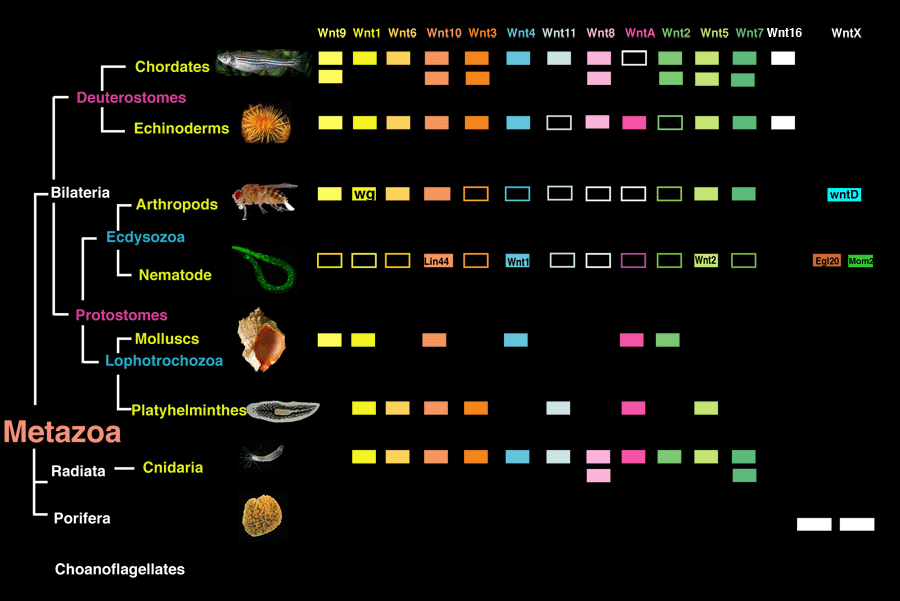
Evolutionary conservation of Wnt signaling (September 2008))
Wnt signaling occurs in all phyla of the animal kingdom. The simplest free-living animals, placozoans which represent a primitive metazoan form have a complete Wnt pathway (Srivastava, 2008). Sponges, one of the earliest branches of metazoa, contain several Wnts and Wnt signaling components, such as Frizzleds, Dickkopf and Dishevelled (Nichols, 2006). Kusserow (2005) found that the genome of the diploblast Nematostella (Cnidaria) contains almost all of the subfamilies of Wnt genes, and that these genes are expressed in a pattern along the axis of the developing embryos. The complexity of the Wnt family suggests a crucial function of Wnt genes in the diversification of eumetazoan body plans. See figure for the evolutionary conservation of the Wnt gene family. Hydra, also belonging to the Cnidaria, has genes encoding the most of the Wnt pathway, including Wnt genes, a Frizzled, beta-catenin and TCF. The Wnt and TCF genes show interesting expression patterns during head formation in Hydra (Hobmayer, 2000). Interestingly, Hydra also has a Dickkopf gene which antagonizes Wnt signaling (Guder, 2006).
Conservation of the chromosomal order of Wnt genes (Nusse, 2001; PDF) is evident in many phyla, including Cnidaria and in Tribolium (Bolognesi, 2008) and Amphioxus (Putnam, 2008).
In the sea anemone Nematostella vectensis, a beta-catenin protein is differentially stabilized along the oral-aboral axis, translocates into nuclei in cells at the site of gastrulation and is used to specify endoderm, indicating an evolutionarily ancient role for this protein in early pattern formation (reviewed in Holstein 2003) (Wikramanayake et al, 2003) Schneider et al (2003) postulate that a single, beta-catenin gene fulfilled both adhesion and signaling functions in the last common ancestor of metazoans some 700 million years ago.
The planarian Girardia tigrina has been found to contain a member of the Wnt family itself (Marsal et al, 2003) Planarians are free-living members (Class Turbellaria) of the Phylum Platyhelminthes. They are known for their high regenerative capabilities and Wnt signaling is indeed important for the correct polarity of regenerating tissues and animals (Peterson, 2008, Gurley, 2008, Iglesias 2008) .
For a recent overview of Wnt signaling components in the sea urchin (Echinoderms; Deuterostomes) see Croce et al, 2006.
There are Wnt signaling components in the slime mold Dictyostelium, including a beta-catenin (aardvark) and GSK3 (reviewed by Weeks). GSK is a highly conserved protein kinase and has also been found in plants (Li 2002). Proteins with the beta-catenin (or armadillo) repeats are also wide-spread and present in plants (Amador 2001) yeast (Pan 1998). However, no evidence for a Wnt itself has been obtained in any of these organisms.
Figure (made by R. Nusse, November 2006). Evolutionary conservation of the Wnt gene family. Most Wnt genes have orthologs throughout the animal kingdom, indicated by similar coloring. Open boxes indicate that these genes are NOT present in genomes that have been completely sequenced, implying that they have been lost during evolution of these phyla. Note that WntX genes are grouped but do not consist of recognizable orthologs, these are outliers that have evolved rapidly. This group includes WntD in Drosophila and Egl20 and Mom2 in C. elegans. The 2 Wnt genes in Porifera (sponges) do not fall yet into a recognizable class of orthologs.
